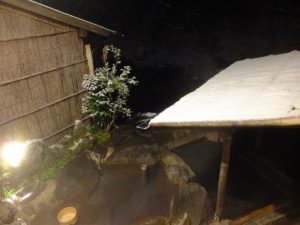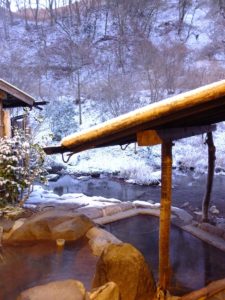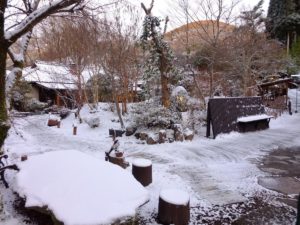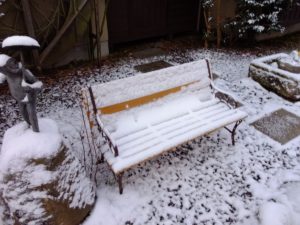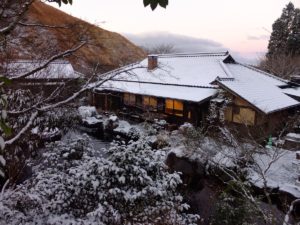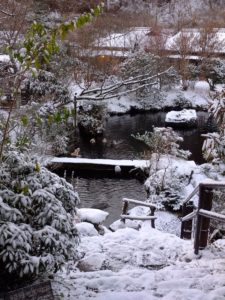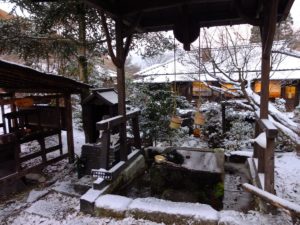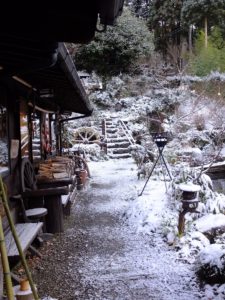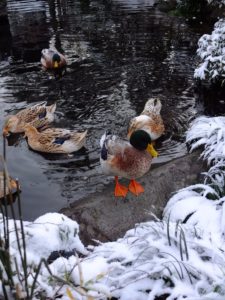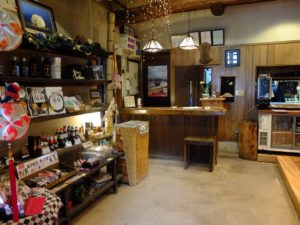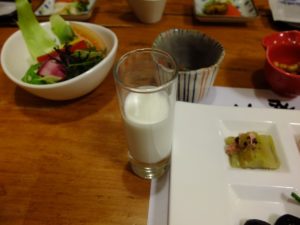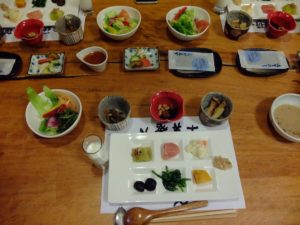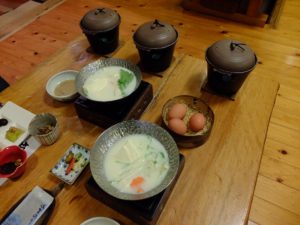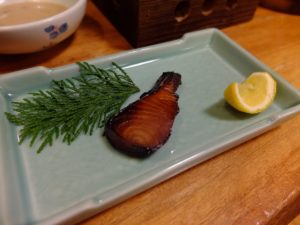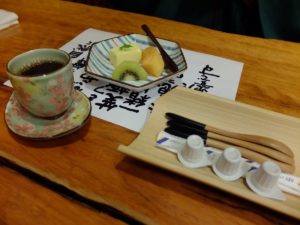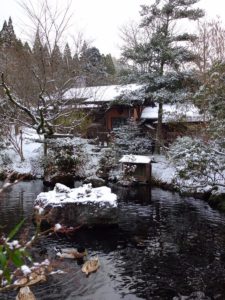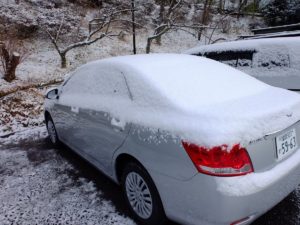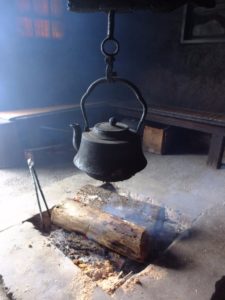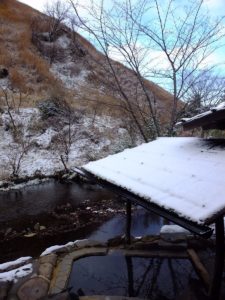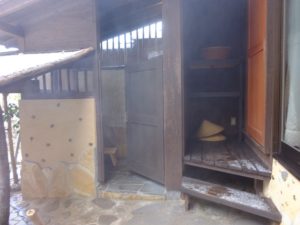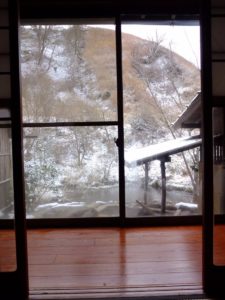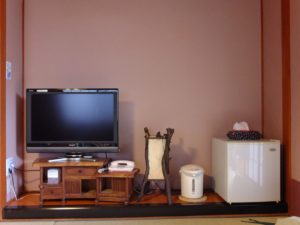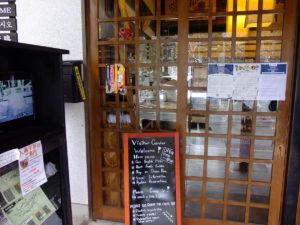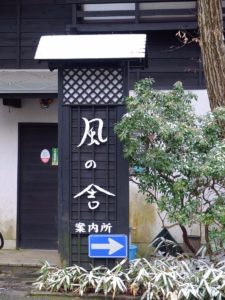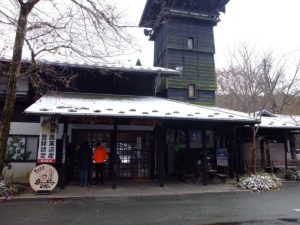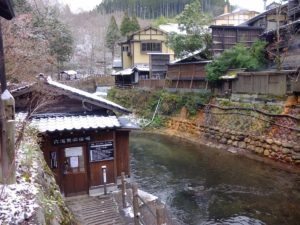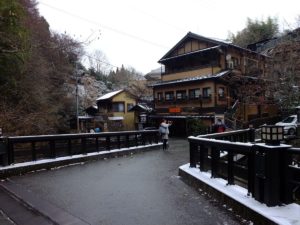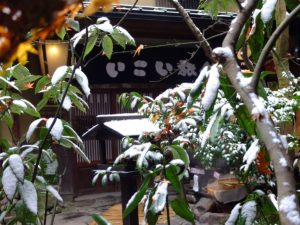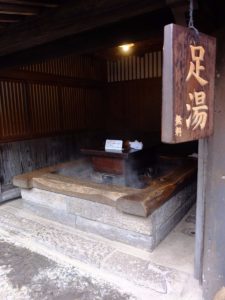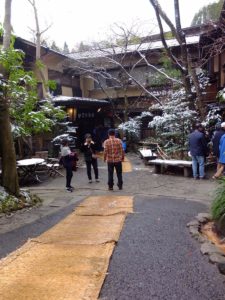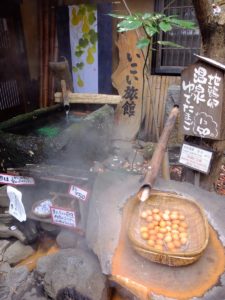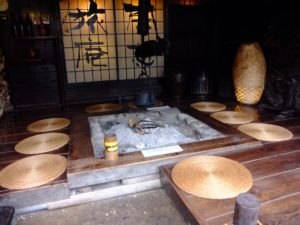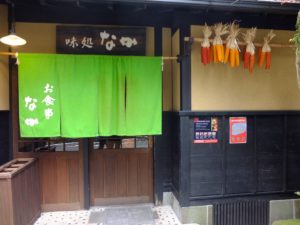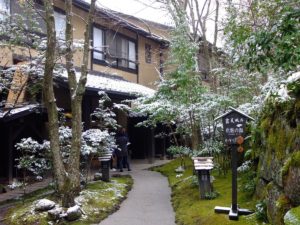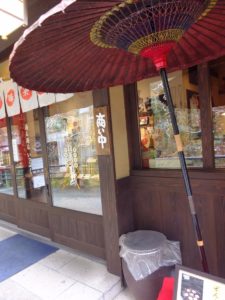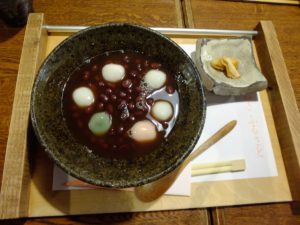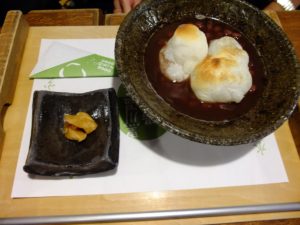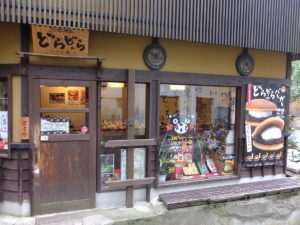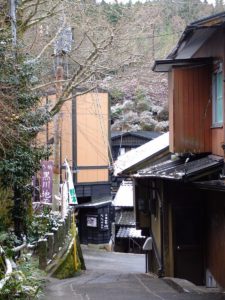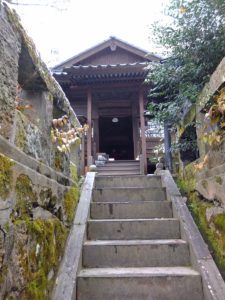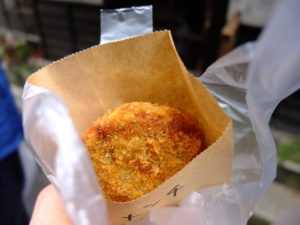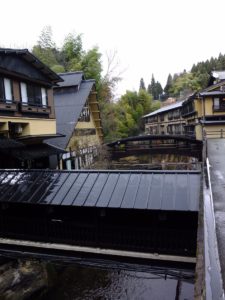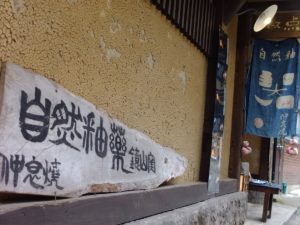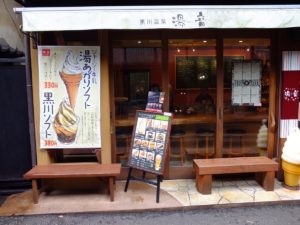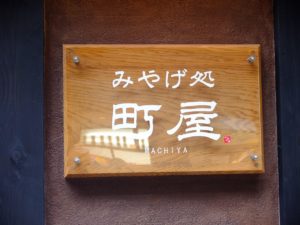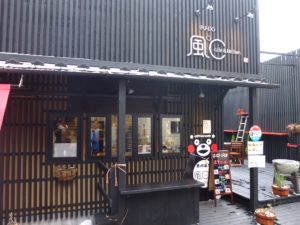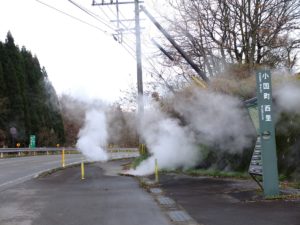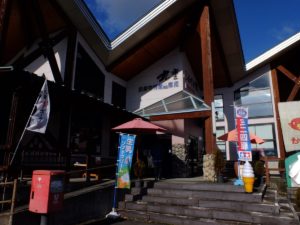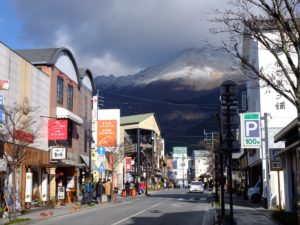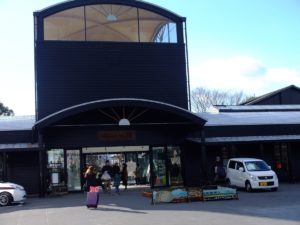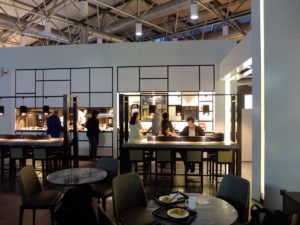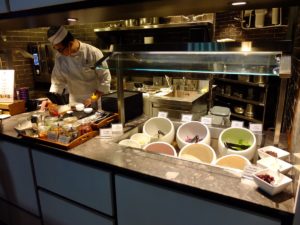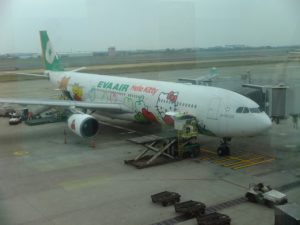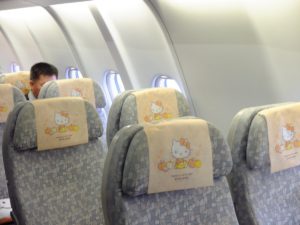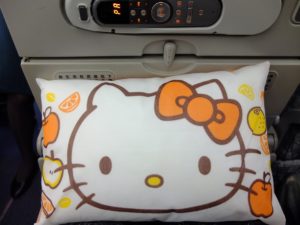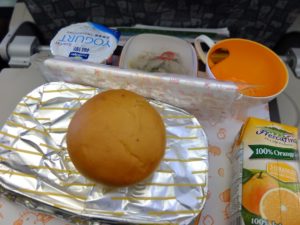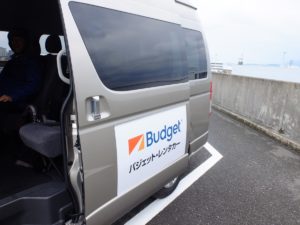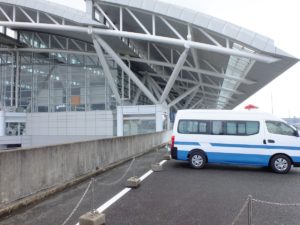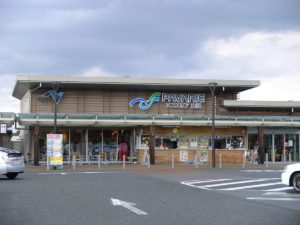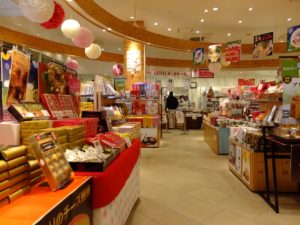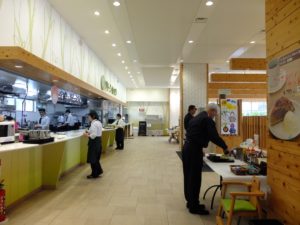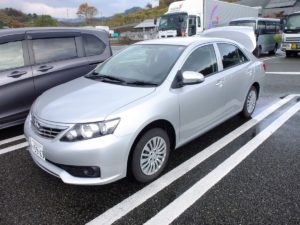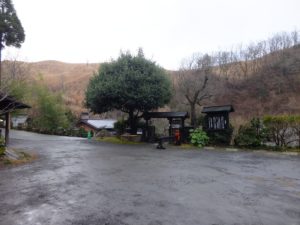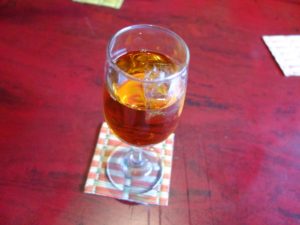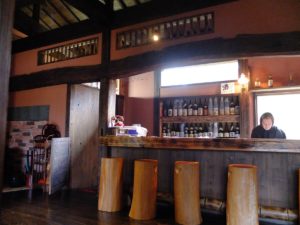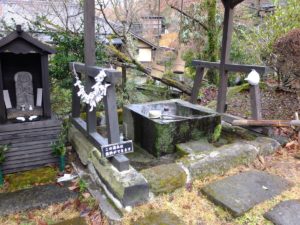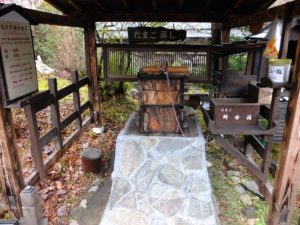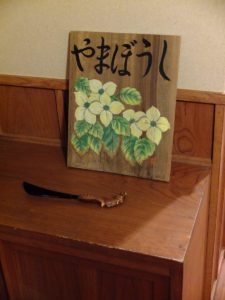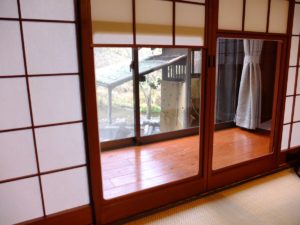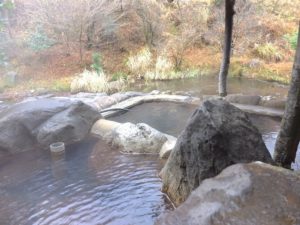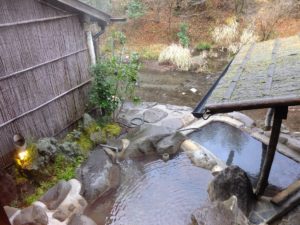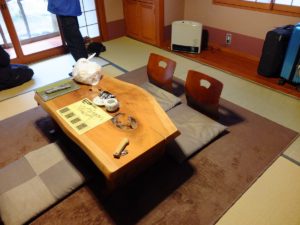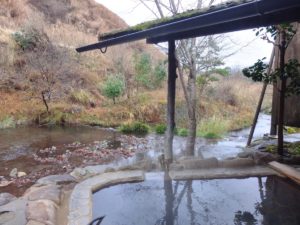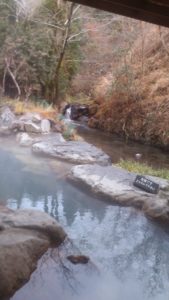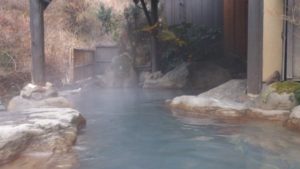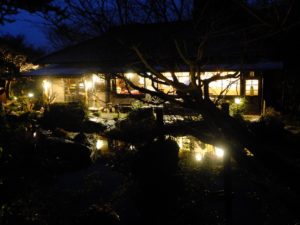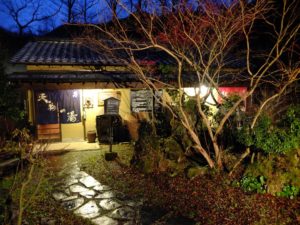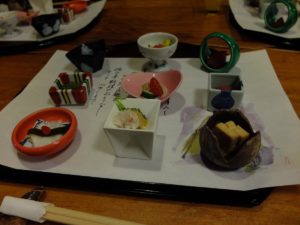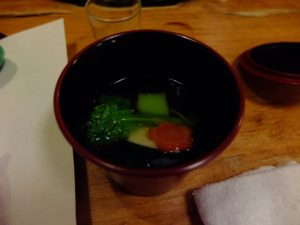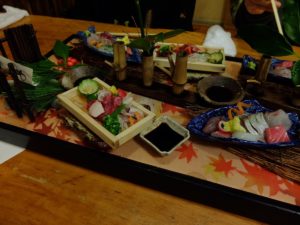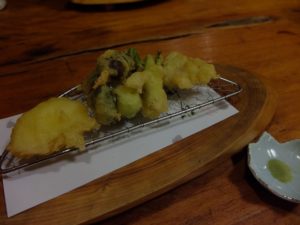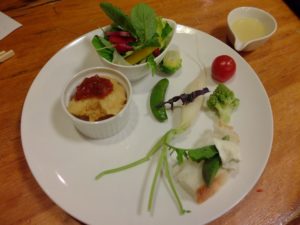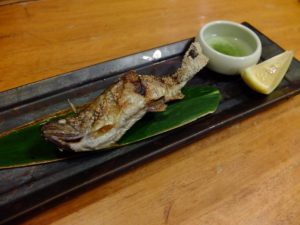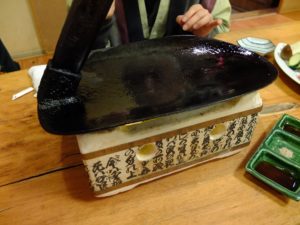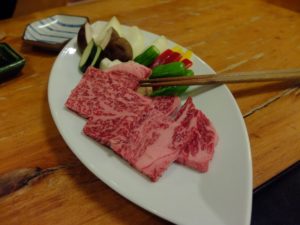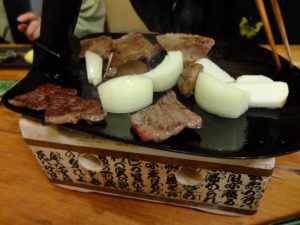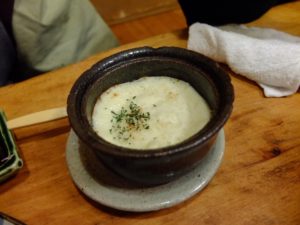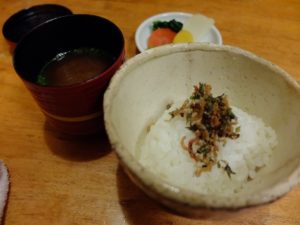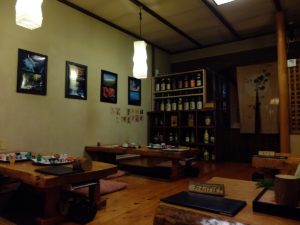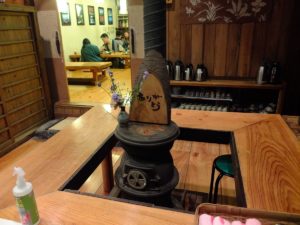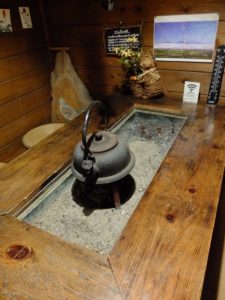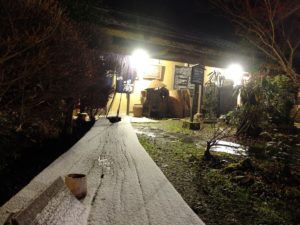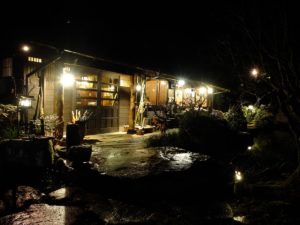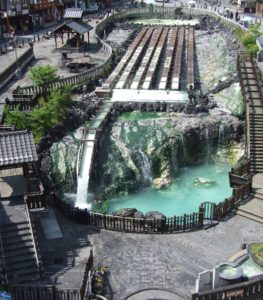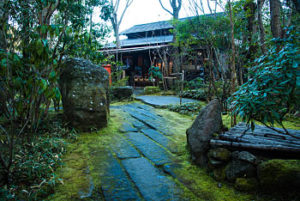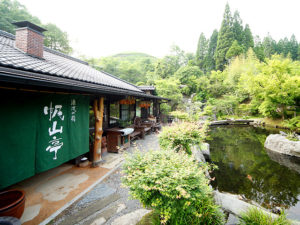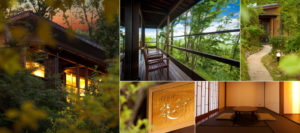Woke up about 3 in the morning to find bath’s awning outside completely covered in thick white layer, and snowing heavily. I was terrified now, what if the roads became sealed off? I checked the road status websites to find all roads to Yufuin under snow gear restriction, meaning either chains or studless tyres. Despite my mom’s attempt to assuage my fears, that even if we were trapped it wouldn’t be a problem, I could barely sleep. I could have requested the car be equipped with studless tyres, but I didn’t.
早上3點起來迎來的是滿天風雪,外頭風呂的遮棚上已厚厚一層白色。這可把我嚇出一身冷汗,若是道路被封閉怎麼辦。看路況網站上往由布院的路都有雪地止滑的限制,需要雪鏈或雪胎。雖然老媽安慰我說就算被困住也不是問題,還是睡不著。原本有機會跟租車公司要求裝雪胎的,但沒有這麼做。
Sunrise, I took a bath in the room’s private onsen. All the hills and rocks was now covered in white, a lovely view which I tried my best to enjoy.
天明了。在房間風呂內泡了下溫泉。所有的山坡和石頭都覆蓋了白色,我也試著放鬆享受這美景。
Before breakfast time I went to the main hall and found the Taiwanese staff there, and I asked him about the conditions. Good news was if it became absolutely necessary it would be possible to swap into studless tyres at the local service shop, however the other local staffs who had been here much longer were not worried and say the light snow would have melted by the time we check out.
早餐前我先去母屋打聽看看,找到那位台灣籍的服務員,問問他認為狀況如何。好消息是必要情形下可以在附近的維修店換雪胎,其他住這裡的在地員工則認為這點雪等到我們要出發時就會融化了,無須擔憂。
I was a little skeptical, but felt much more relieved. Worst case was just a matter of spending some money and changing tyres. Outside, Hozantei’s mascots, a flock of ducks were frolicking in the freezing pond unbothered by the cold, their feathers thick and fluffy.
雖還是有點懷疑,但放心許多了。最糟就是花錢消災換輪胎。外頭,帆山亭的吉祥物們,一群鴨子,無畏寒冷的在冰池中嬉戲,牠們的羽毛厚又毛絨絨的。
Breakfast served at 7:30. Platter of pickles, tofu sides, miso soup, rice and the requisite grilled fish. It was a simple, satisfying meal and we thought better than dinner last night.
早餐7:30開始。各式醬菜,小碟豆腐,味噌湯,白飯和必備的烤魚。簡單,有滿足感的一餐,比昨天晚餐好吃。
Turned out there were two Taiwanese staff working here. Apart from the young man there was another young lady who helped serve our breakfast. My parents struck up a conversation with her and asked about her experience here. The rural onsen towns were facing depopulation, combined with the hard working involved it was difficult to attract new young staffs, so many in the areas turned to people from overseas who were interested in working in Japan. It also had the benefits of helping overcome the language issue with foreign guests.
這才發現原來這裡有兩位台灣籍服務生。除了先前那位年輕人外還有一位小姐今天早上負責我們的早餐。爸媽和她聊上幾句,詢問她在這的經驗。鄉下的溫泉區面臨人口流失,加上旅館的工作不輕鬆,很難吸引到年輕人,於是許多地方便從國外招募想到日本工作的人。這同時也能幫助跟外國住客語言不通的問題。
The sun had fully risen and the riverside view from the room was exquisite. The bright glittering snow contrasted with the dark of the bush and tree branches. Whatever trouble the snow might cause, this view might be worth it along. Had it not snowed the view might have been a barren brown of winter, now it was like a scene out of a traditional ink painting.
太陽完全升起了,房間外的景色相當精緻。閃亮的白雪和黑色的樹叢和枝葉形成強烈對比。不管這雪製造多少麻煩,能見到這景色也值了。若不是這雪外面的景色可能就只是冬天枯黃一片,現在則像幅山水畫。
The staffs were right about the snow. By 10:30 much of the snow on the road had melted away. I’m not sure whether they had sprayed them with water or the asphalt naturally soaked up sunlight more and was warmer; the grass and trees on either side were still covered thickly.
服務員說的不錯,到10:30路上的雪大多都化掉了。不知道他們是不是有灑水或是柏油本來就容易吸熱; 兩旁的草木仍積著厚厚的雪。
The staffs helped carry our luggage up the ramp to the car park, the luggage were held up in the air to avoid them touching the wet grounds. They had already helped brush away the snow from the car windows, though upon the hood and trunk the snow was left there which gave some quite interesting sights later in the day. As we drove chucks of powdery snow would break off and scatter into the wind poetically.
旅館人員幫忙把行李抱到停車場,高高抱著避免行李沾到泥水。他們已經幫忙把車窗上的雪掃掉,車頂和引擎蓋上的則留著,還挺好玩的,之後開著開著就會有一塊雪剝落,瀟灑地在風中灑散。
Hozantei overall was a good experience. There were some bad spots, like the old lady in the first day a little cold (probably due to the language issue). The Taiwanese staffs on other hand were very friendly (probably nice to see someone from back home). CP was average, the room was definitely worth the extra price (I think Standard III is a must, only 2k more than a Standard I but the bath is so much larger plus the shower room). Food was average. The room and ryokan buildings were adequate and traditional, a very rural farmhouse feel to them. It would be better in other seasons as the warmer weather would encourage guests to wander into the main hall and gardens and enjoy some other activities.
帆山亭綜合來說是個不錯的體驗。有些可改進的地方,像第一天的老太太有點冷漠(可能是語言的關係)。台灣籍的服務員則是很友善(大概難得遇到家鄉的人)。CP值普通,房間值多費那點錢(標準III式是基本,多兩千但溫泉池大得多,加上有淋浴間)。吃的還好。房間和旅館建築大致上沒問題,很有傳統味,有鄉間農舍的感覺。在其他季節會好一點,天氣若叫暖就可以在母屋和院子閒逛,享受點其他的活動。
We drove to the tourism centre of Kurokawa Onsen. Parking was very limited in Kurokawa Onsen, this was one of the few spots where one could park. In the peak seasons it might be hard to find a spot and will have to park at the carpark on the outskirt, today there were plenty of space.
我們開到黑川溫泉的旅客中心。黑川溫泉的停車場所有限,這裡是唯一幾個能停車的地方之一。旺季時可能一位難求會需要停到郊區,不過今天位子很多。
One must learn abit of Kurokawa in order to fully appreciate it. Kurokawa is a legend amongst Japanese onsens. What makes it special? Nothing, which is why it is so special.
要體會黑川必須先稍微對他有所了解。黑川在日本溫泉中是個傳奇。他有什麼特別的?沒有,所以才很特別。
The 60s and 70s were Japan’s golden age. In the boom years companies and people were flush with money. Companies would host onsen outings for their employees, and people joined tours and visited onsens for leisure. Onsen tourism exploded and many onsen towns saw big investments.
60和70年代是日本的黃金歲月。經濟飛漲的那個年代公司和人們都很有錢。公司會舉辦員工溫泉旅行,一般人也會參加旅行團去溫泉渡假。溫泉觀光成了當紅炸子雞,許多溫泉村鎮增加了許多大型投資。
Large onsen hotels propped up in onsens that were close to the cities, the most famous being Kinugawa and Atami. These hotels may be 10s of storeys tall, with grand lobbies, shops and theatres. There would be nightly performances to entertain guests, the stereotypical pingpong tables for guests to pass the time, and various gaming machines. These hotels sought to capture guests, satisfy their every possible needs in order to keep them inside and take every yen they spent.
大型溫泉旅館在接近都市的溫泉區一一立起,最有名的就是鬼怒川和熱海。這些旅館可能有10多層樓高,有雄偉的大廳,店鋪和表演廳。晚上會有取樂住客的表演,有老套的乒乓球桌來打磨時間,還有各種遊樂機台。這些旅館試圖綁住住客,滿足他們所有的慾望,盡可能讓他們待在旅館裡拿到他們花費的每一塊錢。
But this destroyed any feeling of an onsen town. Instead of having a sense of township each hotel and ryokan became their own little isolated fortresses, competing against each other with little regard of the overall appeal of the onsen.
但這毀了溫泉村鎮的氣息。取代村鎮向心的是一棟棟各自為政要塞似的飯店和旅館,互相競爭不顧整體溫泉區的受歡迎度。
Then the bubble burst and companies could no longer afford employee trips, the number of visitors to onsen towns fell off a cliff and the huge hotel complexes which costed a fortune to maintain went into the red. As the hotels closed up it caused a downward spiral. Each shuttered hotels and shops became derelicts and made the town felt ever less lively until everything became a deathly quiet broken only by the light of the few hotels that still struggled on. People felt less inclined to visit these onsens.
然而泡沫瓦解了,公司無法再負擔員工旅遊,溫泉區的訪客數雪崩式滑落,需龐大經費維持的大型旅館開始赤字連連。旅館的倒閉造成惡性循環。每一間拉上鐵門的旅館或店家都成了破壞景觀的廢墟,村鎮顯得越來越沒有生氣,直到變成一片死寂,偶爾才被少數苟延殘喘的旅館的燈光暫時打斷。人們更不想去這種溫泉區了。
Kurokawa escaped such fate by a combination of luck and misfortune giving birth to ingenious ideas.
黑川透過從不幸中誕生的智慧,加上一點好運,逃過了這宿命。
Kurokawa is essentially a small onsen town in the middle of nowhere. It has no access to trains and is several hours out from the major cities by car or bus. It has no long history or traditions, no landmarks or famous shrines and temples, its onsen water quality is not spectacular. There’s nothing special about it that distinguishes it from the several hundred other small onsens throughout Japan and while the major onsen towns boomed, the ryokans in Kurokawa merely existed, with only Shinmeikan doing decently due to its open air baths.
黑川基本上是個處在鳥不生蛋之地的小溫泉村。沒有鐵路,從大城市開車或搭巴士也要數小時。沒有歷史或傳統,沒有地標景觀或有名的神社或寺廟,溫泉的泉質也沒好到哪裡。他跟日本其他數百個小溫泉沒什麼不一樣,當大型溫泉村鎮在蓬勃發展時,黑川的旅館只是卑微的存在著,只有新明館因為有露天風呂而比較有人氣。
Then in 1985 the second generation took over running of Shinmeikan and sought to bring changes to the onsen. The idea of running the onsen town as a single entity with a single brand and identity was born. The theme would be open air baths amongst the wild forests. Tree were planted, a standard appearance was adopted throughout town, black signage with white text, black on earthen orange walls for buildings and any unnecessary sign boards removed. The onsen hopping pass was born, for 1200Y (now 1300Y) one could visit any 3 ryokan’s baths, to encourage guests to visit different ryokans and enjoy the feel of different onsen baths, the idea was to treat the entire town as one big onsen ryokan, and selling the hopping pass also gave the tourism association a steady source of income which they could utilize to maintain the town’s appearances and host events.
1985年新明館第二代當家接管後企圖改變黑川溫泉。把整個溫泉村當作單一主體,單一形象和特性的概念產生了。主軸定位為天然樹林中的露天秘湯。他們開始種樹,村內建築的外觀統一為土橙色牆面和黑色樑柱,標示全改為黑底白字,多餘的廣告也全撤除。建立了溫泉手形的制度,只要1200Y(現在1300Y)就可以任選三家旅館泡湯,鼓勵訪客光顧不同的旅館,享受不同的風呂的滋味,這想法是把整個村當作一家大溫泉旅館。而販賣手形也提供當地觀光協會一筆固定收入,可以用來維持村子的整潔和舉行活動。
Because of Kurokawa’s initial lack of investments the town had no large ryokans that would affect the small hidden village in the mountains atmosphere and were able to come together as locals. The town was reborn, against the overall trend of onsen town decline, Kurokawa’s visitor numbers increased 3 fold by the 2000s. Over a million visitors a year for a town less than 4000.
由於黑川一開始並沒有吸引投資,這裡沒有會破壞山中小村氣息的大型旅館,整個溫泉區也能以當地人為出發點凝聚起來動員。整個村子重生了,面對溫泉村鎮普遍的衰退,黑川的訪客數反逆勢高速成長,2000年代時已成長三倍。一個不到四千居民的小鎮一年卻有超過一百萬訪客。
That’s the story of Kurokawa.
黑川溫泉的故事。
I bought a onsen hopper pass from the tourist centre, no intention of using, just a souvenir. The tourist centre also has lockers and provides accommodation booking service, and other general information.
我在遊客中心買了一個溫泉手形,純粹紀念沒有要用。遊客中心有置物櫃,也提供訂房服務和其他觀光詢問。
Kurokawa onsen is not very big, to make a walk around the main street would take about half an hour only, apart from the ryokans there’s only about 10 shops. We went at a leisurely pace, checking out the various ryokans and shops along the way. Many ryokans either also operate restaurants or have public sitting spaces outside to encourage tourists to drop in, take a bath or buy some snacks and other products. Day onsen guests can contribute significantly to a ryokan’s income.
黑川溫泉不大,主街走一趟只要半小時,旅館外不過也就十家店左右。我們用很悠閒的步伐逛著, 檢視沿途的一家家旅館和店鋪。許多旅館也同時經營餐廳或是在門外有可歇息的公共區域,鼓勵遊客入內泡湯,或買點吃的和其它商品。日湯訪客可是旅館收入的重要一環。
For example Ikoi operates a restaurant and offers lunch + onsen packages as well as selling onsen eggs outside with free sitting areas around a warm hearth and footbath. The footbath is also free but usually people would buy a towel for about 200Y. Their daytime operation accounts for 20% of yearly revenue. Many other ryokans also earn about 10% during daytime.
舉來來說,いこい有附屬的餐廳,提供午餐+泡湯的方案,在外頭也有賣溫泉蛋,提供圍繞暖爐的免費座位和足湯。足湯也是免費的,一般會買一條毛巾大約200Y。他們日間營業的收入佔年收入的20%。其他許多旅館日間營業的比重也有10%左右。
We take a break at the Shiratamako, a Japanese sweets cafe specializing in shiratama (a kind of little rice balls) and mochis. The grilled mochi was delicious, it was the first time I had a proper grilled mochi. I had bought mochi before and tried grilling myself but they never tasted right, at last I understand how they are supposed to taste.
我們在白玉團子吃了些茶點,這家日式茶點店專賣類似湯圓的糰子和麻糬。烤麻糬很好吃,這是我第一次吃真正的烤麻糬。從前有買過日式麻糬來自己烤,吃起來總覺不太對,現在我知道味道該是怎樣了。
The main street curves gently uphill. There’s a few souvenir shops, a honey specialist, a cafe selling Aso milk and horse meat buns and croquette, pottery and local sake seller.
彎曲的主街慢慢往上爬。有幾家紀念品店,蜂蜜專賣店,一家賣阿蘇牛奶,馬肉包子和可樂餅,陶藝,還有地酒賣店。
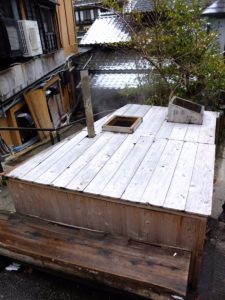
Guess what this is. It’s a facial onsen! Place your face over the opening and feel the onsen’s steam, it’s good for the skin, so they say. 猜猜是什麼… 臉部溫泉浴 臉湊上去感受溫泉的蒸氣可美容
At the end of the main street we decide we should have something to eat before we head for Yufuin. Cafe Fu-Do, meaning Wind Degrees C, had a burger using meat from a local cow breed, akaiushi meaning red cow. Tasted about the same as other beef, nothing special but a decent choice if you felt like something with no surprises. Lunch choices in Kurokawa can be a limited as there were only 2-3 other eateries, not counting the slightly more expensive ryokan restaurants.
在主街盡頭我們決定出發往由布院前先吃點東西。附近的Cafe風C有當地紅牛肉做的漢堡。吃起來跟其他牛肉差不多,沒什麼特別但若不想遇到驚奇的話倒是OK的選項。黑川溫泉午餐選項有限,若不考慮較貴的旅館餐廳大概只有2-3家其他餐館。
We returned to the tourist centre and I asked the staffs for opinion on how to get to Yufuin.
回到遊客中心,我向服務人員詢問該如何去由布院,聽聽他們的意見。
The scenic Yamanami highway was out of question, it went high up in between two tall peaks and was knee deep in snow. The best detour available was the 387 highway that led from Minamioguni to Kokonoe, takes about the same time as the Yamanami highway, however this one was also marked with a snow restriction on the road status website. If the 387 was no good then we would have no choice but backtrack to Hita and take the Oita Expressway, adding over an hour to the original 1 hour journey.
景觀道路やまなみハイウェイ是不可能的,這條路一路往上從兩座山峰間通過,現在雪深及膝。最好的繞道選項是387公路,從南小國町通到九重,所需時間和やまなみハイウェイ差不多,但這條在道路狀況網站上也有標示雪地限制。如果387公路不行的話就必須走回路到日田再走大分高速,這樣會多繞一小時。
The staffs weren’t so sure about highway 387. It may be okay, they suggested.
服務人員不太確定387公路。或許可以走吧,他們這樣說。
My parents suggested we should give it a try, if not we can still take the detour to Hita. It was a good thing we did, the road status website must be a little slow in updating information as we saw no sign of road restrictions on the way. The road surface had less snow than areas around Kurokawa.
爸媽建議走走看,若真不行再繞日田。幸好我們有走,道路狀況網站大概更新沒那麼快,我們一路上都沒看到限制行駛的跡象。道路上的雪比黑川一帶還少。
Initially I was nervous and constant expected to see a check point. We descended the mountains and it turned to elation. The scenery along the way was quite beautiful, plenty of rolling woods and hills. There are a lot of onsens along the way, can’t go a 5 minutes without running into signs pointing to onsen hotels. There was a small stretch of road where steam was readily rising out of the sides.
一開始還很緊張,一直認為會遇到檢查點。慢慢下山後心情才轉為開朗。兩側的風景很好,有許多綿延的山丘和樹林。一路上都是溫泉,走沒五分鐘就會看到溫泉旅館的指標。其中有一小段路兩側還不斷冒出蒸氣呢。
Kokonoe showed that we had cleared the snow area completely; the path to Yufuin was now assured. We take a short break at the information and local produce promotion centre at the intersection.
到九重代表已經脫離雪區; 到由布院的路途確認沒問題了。我們在交叉路口的農產特銷觀光所停了下。
Because we left early incase we had to detour via Hita, we now looked to reach Ryu no Hige ahead of schedule. Given that we decided to drive through Yufuin main street first instead, get a feel for the town, confirm where the rental return and petrol station are, and pick up our train tickets so there’s one less thing to do tomorrow.
由於可能會需要繞日田,我們離開黑川的時間比計畫得早許多。現在到龍之鬍鬚變的會太早,於是我們先繞去由布院主街一趟,確認還車和加油站地點,順便取火車票這樣明天就少一件必做的事。
We parked at a 7-11 near the station, I went for the ticket while my parents went inside for some shopping. Convenience store parking is probably the best source of temporary parking in Japan, easy to find and so long as you bought something all is okay.
我們停在車站附近的一家7-11。我去拿票時爸媽就在裡頭逛。便利商店停車場大概是日本最方便的臨時停車方法,只要有買點東西就好了。
We bought more bread and a bottle of sake for dad, after that we head for Ryu no Hige, which must be discussed in its own chapter.
我們買了些麵包,還有爸要的大吟釀。然後前往龍之鬍鬚,關於這旅館的事必須另外一篇介紹。
